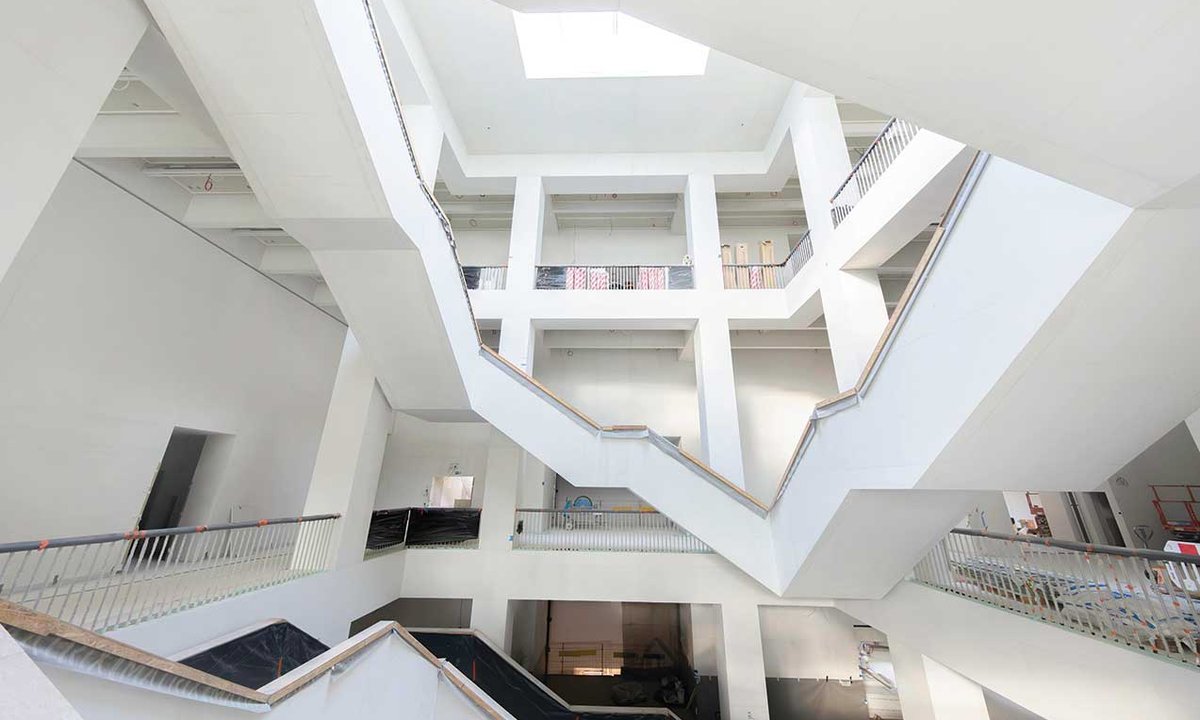[ad_1]
After existing for almost two decades without a permanent home, one of Poland’s most important cultural institutions, the Museum of Modern Art in Warsaw (MSN Warsaw), is preparing to open a major new building in the heart of the Polish capital this month.
Costing around $145m and entirely funded by the city of Warsaw, the 213,000 sq. ft museum, cloaked in striking white concrete, is designed by the New York-based architects Thomas Phifer and Partners.
Sitting close to the Communist-era Palace of Culture and Science, in Warsaw’s vast Defilad (Parade) Square, the new building will be unveiled to the public in a two-phase opening that begins with a three-week festival starting on 25 October. The fully installed galleries, showing MSN’s collection of post-Second World War Polish and international art, are then scheduled to open in February 2025.
Describing the new building as “an opportunity”, MSN’s longstanding director, Joanna Mytkowska, says the institution “will be able to invite and work with a much larger audience, we can widen our field of dialogue, and produce a broader and more thorough exhibition programme. At the same time, we hope to retain our flexibility and the feisty spirit of our origins.”
Founded in 2005, MSN has operated across a number of different spaces, including most recently in a pavilion beside the Vistula river. Plans for an earlier version of the museum’s permanent home, designed by the Swiss architect Christian Kerez, collapsed in 2012 following disputes over requests from Warsaw’s authorities to include space for the TR Warszawa theatre. Following a new architectural competition, Thomas Phifer and Partners were chosen in 2014 to design adjacent buildings for MSN and the theatre.
The “elegant and pure structure” was designed by Thomas Phifer and Partners
Photo: Marta Ejsmont; courtesy of MSN Warsaw
Noting that Poland is currently experiencing “a remarkable renaissance”, which he says has led to the construction of around 30 new cultural buildings in the last ten years, Thomas Phifer says MSN’s new home will act as a “cultural voice” in dialogue with the site’s historic location.
“We had the presence of the Palace of Culture on the western side of the site, and on the eastern side, commercial architecture that was constructed from the 1990s to the present day,” Phifer says. “The museum lives in between the presence of this diverse and emotional history.”
An architecture of encounters
Describing the ground floor of the new museum as a “cultural forum”, Phifer says the building “promises an architecture of encounters, a place for people, a new town square, a platform for engaging contemporary culture, and a place for dialogue and discourse embedded in the city’s life”.
Mytkowska has led MSN since June 2007, shortly before Poland’s current prime minister, Donald Tusk, began his first term in office. Despite the later period of right-wing rule from 2015-2023, when Poland’s governing Law and Justice Party was frequently at loggerheads with the arts sector, and a number of institutions saw their directors replaced, Mytkowska survived.
MSN was jointly overseen by Poland’s ministry of culture and the city of Warsaw until 2022, when the latter took over sole responsibility. With Tusk back in office following the country’s 2023 elections, it seems central government may again be given a stake in the institution’s management.
Given MSN’s “national and international profile”, Mytkowska says “there are ongoing discussions between the city and the new government about being overseen by both the city of Warsaw and ministry of culture.”
She adds that the museum hopes “to further develop the collection by bringing in works from the local scene and the distinctive Eastern European tradition as well as the transnational development of artistic practices”. Among the artists currently represented in the collection are many women, including Magdalena Abakanowicz, Mária Bartuszová, Sarah Lucas, Ewa Juszkiewicz, Sandra Mujinga, Senga Nengudi, Alina Szapocznikow, Rebecca H. Quaytman and Vivian Suter, she says.
While there has previously been frustration with the delays in realising MSN’s permanent home, commentators in Poland say there is now considerable excitement about the opening.
According to Marta Czyż, the art historian and curator behind Poland’s participation at the 2024 Venice Biennale, Mytkowska and her team are respected for having persevered in maintaining MSN’s trajectory while navigating the changes in Polish politics.
MSN has been able to respond “in real time to what is happening in art and the world”, Czyż says, adding that it has built “one of the most important collections, in Poland and worldwide. It is a young collection, but with a very thoughtful curatorial concept. It includes works by artists working after the war, who not only touched or are touching on current issues, but also create a consistent narrative, a story of post-war art history.”
Having recently visited the building, Jack Lohman, the chair of Poland’s National Institute for Museums and former director of the Museum of London, says MSN’s new home “is an elegant and simple pure structure with generous gallery spaces on two upper floors that open up with views through enormous picture windows onto Warsaw.”
Lohman says that MSN can expect to be “seen more and more as the home of contemporary art in Poland.”
“From an operational perspective, its overall size, its generous range of spaces and logical back-of-house facilities, and, of course, its superb downtown location, guarantee its success,” he says.
[ad_2]
Source link

